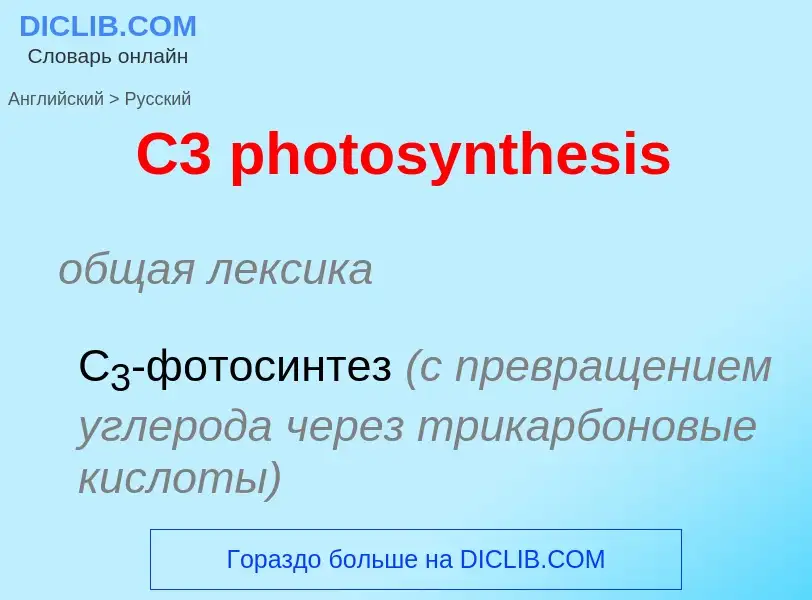Перевод и анализ слов искусственным интеллектом ChatGPT
На этой странице Вы можете получить подробный анализ слова или словосочетания, произведенный с помощью лучшей на сегодняшний день технологии искусственного интеллекта:
- как употребляется слово
- частота употребления
- используется оно чаще в устной или письменной речи
- варианты перевода слова
- примеры употребления (несколько фраз с переводом)
- этимология
C3 photosynthesis - перевод на русский
общая лексика
C3-фотосинтез (с превращением углерода через трикарбоновые кислоты)
общая лексика
C3-растение (по типу фотосинтеза)
общая лексика
первичный продукт фотосинтеза
Википедия
C3 carbon fixation is the most common of three metabolic pathways for carbon fixation in photosynthesis, along with C4 and CAM. This process converts carbon dioxide and ribulose bisphosphate (RuBP, a 5-carbon sugar) into two molecules of 3-phosphoglycerate through the following reaction:
- CO2 + H2O + RuBP → (2) 3-phosphoglycerate
This reaction was first discovered by Melvin Calvin, Andrew Benson and James Bassham in 1950. C3 carbon fixation occurs in all plants as the first step of the Calvin–Benson cycle. (In C4 and CAM plants, carbon dioxide is drawn out of malate and into this reaction rather than directly from the air.)
Plants that survive solely on C3 fixation (C3 plants) tend to thrive in areas where sunlight intensity is moderate, temperatures are moderate, carbon dioxide concentrations are around 200 ppm or higher, and groundwater is plentiful. The C3 plants, originating during Mesozoic and Paleozoic eras, predate the C4 plants and still represent approximately 95% of Earth's plant biomass, including important food crops such as rice, wheat, soybeans and barley.
C3 plants cannot grow in very hot areas at today's atmospheric CO2 level (significantly depleted during hundreds of millions of years from above 5000 ppm) because RuBisCO incorporates more oxygen into RuBP as temperatures increase. This leads to photorespiration (also known as the oxidative photosynthetic carbon cycle, or C2 photosynthesis), which leads to a net loss of carbon and nitrogen from the plant and can therefore limit growth.
C3 plants lose up to 97% of the water taken up through their roots by transpiration. In dry areas, C3 plants shut their stomata to reduce water loss, but this stops CO2 from entering the leaves and therefore reduces the concentration of CO2 in the leaves. This lowers the CO2:O2 ratio and therefore also increases photorespiration. C4 and CAM plants have adaptations that allow them to survive in hot and dry areas, and they can therefore out-compete C3 plants in these areas.
The isotopic signature of C3 plants shows higher degree of 13C depletion than the C4 plants, due to variation in fractionation of carbon isotopes in oxygenic photosynthesis across plant types. Specifically, C3 plants do not have PEP carboxylase like C4 plants, allowing them to only utilize ribulose-1,5-bisphosphate carboxylase (Rubisco) to fix CO2 through the Calvin cycle. The enzyme Rubisco largely discriminates against carbon isotopes, evolving to only bind to 12C isotope compared to 13C (the heavier isotope), attributing to why there's a low 13C depletion seen in C3 plants compared to C4 plants especially since the C4 pathway uses PEP carboxylase in addition to Rubisco.

![Cross section of a {{C3}} plant, specifically of an ''[[Arabidopsis thaliana]]'' leaf. Vascular bundles shown. Drawing based on microscopic images courtesy of Cambridge University Plant Sciences Department. Cross section of a {{C3}} plant, specifically of an ''[[Arabidopsis thaliana]]'' leaf. Vascular bundles shown. Drawing based on microscopic images courtesy of Cambridge University Plant Sciences Department.](https://commons.wikimedia.org/wiki/Special:FilePath/Cross section of Arabidopsis thaliana, a C3 plant..jpg?width=200)
